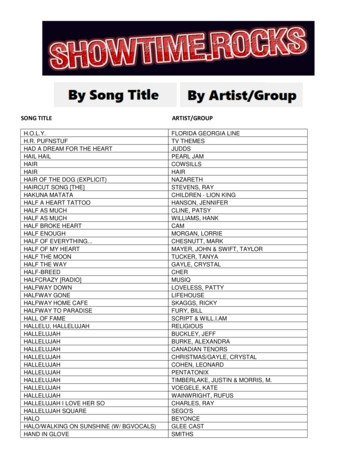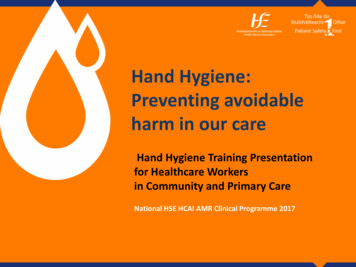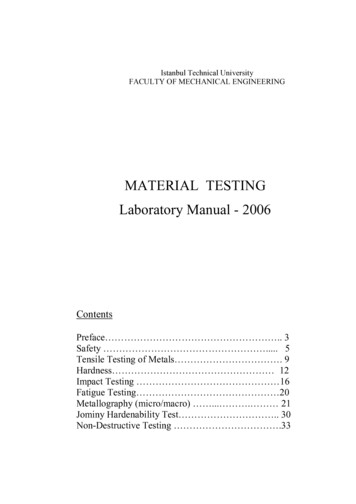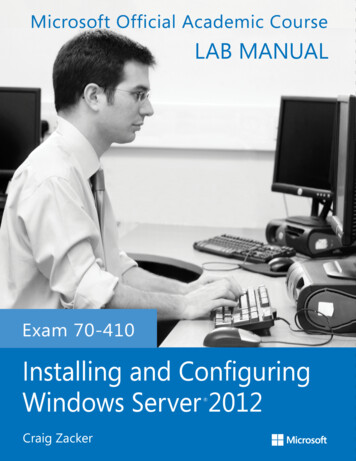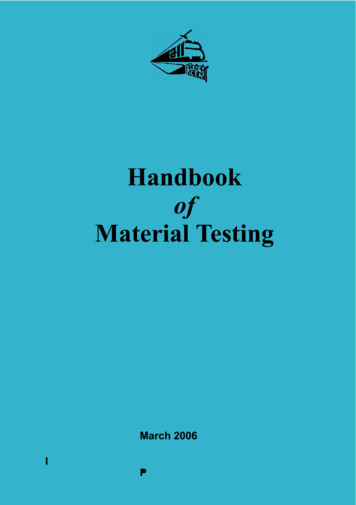
Transcription
HandbookofMaterial TestingMarch 2006
HandbookofMaterial Testing
PREFACEWhile designing a structure, engineer assumes certain value ofstrength for each of material being used therein. When thestructure is being constructed, it is the bounden duty of the fieldengineers to get the same validated by regular testing of material.The quality of materials used in any infrastructure does play a vitalrole with regard to its ultimate strength and durability in the longrun. Hence, the materials need to be tested according to certainstandard procedures developed by ASTM, BIS, RDSO to give aclear picture of material strength.The “Handbook of Material Testing” is an attempt by IRICEN tobring together the standard test procedures for materials frequentlyused in the civil engineering infrastructure of Indian Railways. It ishoped that this will be a helpful guide to the field engineers. A listof suppliers of various testing equipments has also been providedalongwith their addresses to enable the engineers in setting up ofa field laboratory, in case the need be.Any suggestions to ameliorate the content of this handbookwould be welcome.Shiv KumarDirectorIRICEN, Pune
ACKNOWLEDGEMENTStrength and durability of any infrastructure is a reflection of thequality of materials used. Quality control of materials can only beensured through certain standard test procedures designed byASTM, BIS, RDSO and others.The “Handbook of Material Testing” is an attempt towards thisaim, of creating a collection of standard test procedures formaterials, commonly used in civil engineering infrastructure on theIndian Railways. This will serve as a guide to the field engineers.The readers are advised in their interest to refer to the lateststandards to avoid any omission, due to changes/amendments inthe standards. The handbook also includes a list of suppliers ofmaterial testing equipments, alongwith their addresses to facilitatethe setting up of a field laboratory.The support rendered by the faculty and staff of IRICEN in thisendeavour, needs mention. Shri Praveen Kumar, Professor/Computers and Shri J.M. Patekari, Chief Technical Assistant,have been of technical assistance and Shri Vijayakumaran. V, myPersonal Assistant, has been extremely useful in the task of wordprocessing.I am thankful to Shri Shiv Kumar, Director/IRICEN for hisguidance and encouragement.R.K. VermaSr. Professor/TrackIRICEN, Pune
Table of Contents1.Tests on Cement1.1 Fineness11.2 Consistency31.3 Initial and final setting time51.4 Soundness72.Tests on Aggregates2.1 Sieve analysis92.2 Water absorption132.3 Aggregate abrasion value152.4 Aggregate impact value182.5 Aggregate crushing value213.Tests on Fresh Concrete3.1 Workability233.1.1 Slump233.1.2 Compacting factor253.1.3 Vee-Bee274.Tests on Hardened Concrete4.1 Non-destructive tests294.1.1 Rebound hammer294.1.2 Ultrasonic pulse velocity314.2 Compression test34
5.Tests on Soil5.1 Water content385.1.1 Oven drying method385.1.2 Calcium carbide method415.2 Particle size distribution445.3 Liquid limit475.4 Plastic limit505.5 Free swell index525.6 Specific gravity545.7 Maximum dry density and optimum moisture content575.8 In-situ dry density615.8.1 Core cutter method615.8.2 Sand replacement method636. Tests on Blanket Material687. Tests on Bitumen7.1 Bitumen content727.2 Specific gravity747.3 Marshall stability767.4 Penetration787.5 Flash point and fire point807.6 Softening point7.7 Ductility8386ANNEXURESList of suppliers of material testing equipmentsalongwith their addresses89 to 99100
1. TESTS ON CEMENT1.1 FINENESSAIMTo determine the fineness of cement by dry sieving as perIS: 4031 (Part 1) - 1996.PRINCIPLEThe fineness of cement is measured by sieving it through astandard sieve. The proportion of cement, the grain sizes ofwhich, is larger than the specified mesh size is thus determined.APPARATUSFIG. 1 : IS SIEVEi)90µm IS Sieveii)Balance capable of weighing 10g to the nearest 10mgiii) A nylon or pure bristle brush, preferably with 25 to 40mmbristle, for cleaning the sieve1
PROCEDUREi)Weigh approximately 10g of cement to the nearest 0.01g andplace it on the sieve.ii) Agitate the sieve by swirling, planetary and linearmovements, until no more fine material passes through it.iii) Weigh the residue and express its mass as a percentage R1,of the quantity first placed on the sieve to the nearest 0.1percent.iv) Gently brush all the fine material off the base of the sieve.v)Repeat the whole procedure using a fresh 10g sample toobtain R2. Then calculate R as the mean of R1 and R2 as apercentage, expressed to the nearest 0.1 percent. When theresults differ by more than 1 percent absolute, carry out athird sieving and calculate the mean of the three values.REPORTING OF RESULTSReport the value of R, to the nearest 0.1 percent, as the residueon the 90µm sieve.2
1.2 CONSISTENCYAIMTo determine the quantity of water required to produce a cementpaste of standard consistency as per IS: 4031 (Part 4) - 1988.PRINCIPLEThe standard consistency of a cement paste is defined as thatconsistency which will permit the Vicat plunger to penetrate to apoint 5 to 7mm from the bottom of the Vicat mould.APPARATUSFIG. 2 : VICAT APPARATUSi)Vicat apparatus conforming to IS: 5513 - 1976ii)Balance, whose permissible variation at a load of 1000gshould be 1.0giii)Gauging trowel conforming to IS: 10086 - 19823
PROCEDUREi)Weigh approximately 400g of cement and mix it with aweighed quantity of water. The time of gauging should bebetween 3 to 5 minutes.ii)Fill the Vicat mould with paste and level it with a trowel.iii)Lower the plunger gently till it touches the cement surface.iv)Release the plunger allowing it to sink into the paste.v)Note the reading on the gauge.vi)Repeat the above procedure taking fresh samples of cementand different quantities of water until the reading on thegauge is 5 to 7mm.REPORTING OF RESULTSExpress the amount of water as a percentage of the weight ofdry cement to the first place of decimal.4
1.3 INITIAL AND FINAL SETTING TIMEAIMTo determine the initial and the final setting time of cementas per IS: 4031 (Part 5) - 1988.APPARATUSi)Vicat apparatus conforming to IS: 5513 - 1976ii)Balance, whose permissible variation at a load of 1000gshould be 1.0giii)Gauging trowel conforming to IS: 10086 - 1982PROCEDUREi)Prepare a cement paste by gauging the cement with 0.85times the water required to give a paste of standardconsistency (see Para 1.2).ii)Start a stop-watch, the moment water is added to thecement.iii)Fill the Vicat mould completely with the cement pastegauged as above, the mould resting on a non-porous plateand smooth off the surface of the paste making it level withthe top of the mould. The cement block thus prepared in themould is the test block.A)INITIAL SETTING TIMEPlace the test block under the rod bearing the needle.Lower the needle gently in order to make contact with thesurface of the cement paste and release quickly, allowing itto penetrate the test block. Repeat the procedure till theneedle fails to pierce the test block to a point 5.0 0.5mmmeasured from the bottom of the mould.5
The time period elapsing between the time, water is addedto the cement and the time, the needle fails to pierce thetest block by 5.0 0.5mm measured from the bottom of themould, is the initial setting time.B)FINAL SETTING TIMEReplace the above needle by the one with an annularattachment.The cement should be considered as finally set when, uponapplying the needle gently to the surface of the test block,the needle makes an impression therein, while theattachment fails to do so. The period elapsing between thetime, water is added to the cement and the time, the needlemakes an impression on the surface of the test block, whilethe attachment fails to do so, is the final setting time.REPORTING OF RESULTSThe results of the initial and the final setting time should bereported to the nearest five minutes.6
1.4 SOUNDNESSAIMTo determine the soundness of cement by Le-Chatelier methodas per IS: 4031 (Part 3) - 1988.APPARATUSFIG. 3 : LE-CHATELIER'S TEST APPARATUSi)The apparatus for conducting the Le-Chatelier test shouldconform to IS: 5514 - 1969ii)Balance, whose pemissible variation at a load of 1000gshould be 1.0giii)Water bathPROCEDUREi)Place the mould on a glass sheet and fill it with the cementpaste formed by gauging cement with 0.78 times the waterrequired to give a paste of standard consistency (seePara 1.2).7
ii)Cover the mould with another piece of glass sheet, place asmall weight on this covering glass sheet and immediatelysubmerge the whole assembly in water at a temperature ofo27 2 C and keep it there for 24hrs.iii)Measure the distance separating the indicator points to thenearest 0.5mm (say d l ).iv)Submerge the mould again in water at the temperatureprescribed above. Bring the water to boiling point in 25 to 30minutes and keep it boiling for 3hrs.v)Remove the mould from the water, allow it to cool andmeasure the distance between the indicator points (say d 2 ).vi)(d 2 – d l ) represents the expansion of cement.REPORTING OF RESULTSCalculate the mean of the two values to the nearest 0.5mm torepresent the expansion of cement.8
2. TESTS ON AGGREGATES2.1 SIEVE ANALYSISAIMTo determine the particle size distribution of fine and coarseaggregates by sieving as per IS: 2386 (Part I) - 1963.PRINCIPLEBy passing the sample downward through a series of standardsieves, each of decreasing size openings, the aggregates areseparated into several groups, each of which contains aggregatesin a particular size range.APPARATUSFIG. 4 : A SET OF IS SIEVES9
i)A set of IS Sieves of sizes - 80mm, 63mm, 50mm, 40mm,31.5mm, 25mm, 20mm, 16mm, 12.5mm, 10mm, 6.3mm,4.75mm, 3.35mm, 2.36mm, 1.18mm, 600µm, 300µm, 150µmand 75µmii)Balance or scale with an accuracy to measure 0.1 percentof the weight of the test sampleSAMPLEThe weight of sample available should not be less than theweight given below:Maximum size presentin substantialproportions(mm)Minimum weight ofsample despatchedfor 33The sample for sieving should be prepared from the larger sampleeither by quartering or by means of a sample divider.PROCEDUREi)The test sample is dried to a constant weight at aotemperature of 110 5 C and weighed.10
ii)The sample is sieved by using a set of IS Sieves.iii)On completion of sieving, the material on each sieve isweighed.iv)Cumulative weight passing through each sieve is calculatedas a percentage of the total sample weight.v)Fineness modulus is obtained by adding cumulativepercentage of aggregates retained on each sieve and dividingthe sum by 100.REPORTING OF RESULTSThe results should be calculated and reported as:i)the cumulative percentage by weight of the total sampleii)the percentage by weight of the total sample passingthrough one sieve and retained on the next smaller sieve, tothe nearest 0.1 percent.The results of the sieve analysis may be recorded graphically ona semi-log graph with particle size as abscissa (log scale) andthe percentage smaller than the specified diameter as ordinate.A sample chart is provided on page 12.11
12PERCENTAGE 64.75101625 APERTURE SIZE IN MICRONS APERTURE SIZE IN MILLIMETRES405080 63CHART FOR RECORDING SIEVE ANALYSIS RESULTSSIEVE SIZESNote - The vertical scale of this chart is an arithmetic scale and the horizontal scale is logarithmic. 7520406080100
2.2 WATER ABSORPTIONAIMTo determine the water absorption of coarse aggregates as perIS: 2386 (Part III) - 1963.APPARATUSi)Wire basket - perforated, electroplated or plastic coated withwire hangers for suspending it from the balanceii)Water-tight container for suspending the basketiii)Dry soft absorbent cloth - 75cm x 45cm (2 nos.)iv)Shallow tray of minimum 650 sq.cm areav)Air-tight container of a capacity similar to the basketvi)OvenSAMPLEA sample not less than 2000g should be used.PROCEDUREi)The sample should be thoroughly washed to remove finerparticles and dust, drained and then placed in the wirebasket and immersed in distilled water at a temperatureobetween 22 and 32 C.ii)After immersion, the entrapped air should be removed bylifting the basket and allowing it to drop 25 times in 25seconds. The basket and sample should remain immersedfor a period of 24 ½ hrs. afterwards.iii)The basket and aggregates should then be removed from thewater, allowed to drain for a few minutes, after which the13
aggregates should be gently emptied from the basket on toone of the dry clothes and gently surface-dried with thecloth, transferring it to a second dry cloth when the firstwould remove no further moisture. The aggregates should bespread on the second cloth and exposed to the atmosphereaway from direct sunlight till it appears to be completelysurface-dry. The aggregates should be weighed (Weight 'A').iv)The aggregates should then be placed in an oven at aotemperature of 100 to 110 C for 24hrs. It should then beremoved from the oven, cooled and weighed (Weight 'B').REPORTING OF RESULTSA - BWater absorption ———– x 100%BTwo such tests should be done and the individual and meanresults should be reported.A sample proforma for the record of the test results is given inAnnexure-I.14
2.3 AGGREGATE ABRASION VALUEAIMTo determine the abrasion value of coarse aggregates as perIS: 2386 (Part IV) - 1963.APPARATUSFIG. 5 : LOS ANGLES MACHINEi)Los Angles abrasion testing machineii)IS Sieve of size - 1.7mmiii)Abrasive charge - 12 nos. cast iron or steel spheresapproximately 48mm dia. and each weighing between 390and 445g ensuring that the total weight of charge is 5000 25giv)Oven15
PREPARATION OF SAMPLEThe test sample should consist of clean aggregates which hasobeen dried in an oven at 105 to 110 C to a substantially constantweight and should conform to one of the gradings shown in thetable below:Grading of test samplesSieve size(Square hole)Passingthrough(mm)Weight in g of test sample for 500*--5040----5000* ----12.51012502500------5000* 00---* Tolerance of 2 percent permitted.PROCEDUREThe test sample and the abrasive charge should be placed in theLos Angles abrasion testing machine and the machine rotated ata speed of 20 to 33 revolutions/minute for 1000 revolutions. Atthe completion of the test, the material should be discharged andsieved through 1.70mm IS Sieve.16
REPORTING OF RESULTSi)The material coarser than 1.70mm IS Sieve should beowashed, dried in an oven at a temperature of 100 to 110 C toa constant weight and weighed (Weight 'B').ii)The proportion of loss between weight 'A' and weight 'B' ofthe test sample should be expressed as a percentage of theoriginal weight of the test sample. This value should bereported as,A - BAggregate abrasion value ———– x 100%AA sample proforma for the record of the test results is given inAnnexure-II.17
2.4 AGGREGATE IMPACT VALUEAIMTo determine the aggregate impact value of coarse aggregatesas per IS: 2386 (Part IV) - 1963.APPARATUSFIG. 6 : AGGREGATE IMPACT TEST MACHINEi)Impact testing machine conforming to IS: 2386 (Part IV)- 1963ii)IS Sieves of sizes - 12.5mm, 10mm and 2.36mmiii)A cylindrical metal measure of 75mm dia. and 50mm depthiv)A tamping rod of 10mm circular cross section and 230mmlength, rounded at one endv)Oven18
PREPARATION OF SAMPLEi)The test sample should conform to the following grading:-Passing through 12.5mm IS Sieve100%-Retention on 10mm IS Sieve100%ii)The sample should be oven-dried for 4hrs. at a temperatureoof 100 to 110 C and cooled.iii)The measure should be about one-third full with the preparedaggregates and tamped with 25 strokes of the tamping rod.A further similar quantity of aggregates should be added anda further tamping of 25 strokes given. The measure shouldfinally be filled to overflow, tamped 25 times and the surplusaggregates struck off, using a tamping rod as a straightedge. The net weight of the aggregates in the measureshould be determined to the nearest gram (Weight 'A').PROCEDUREi)The cup of the impact testing machine should be fixed firmlyin position on the base of the machine and the whole of thetest sample placed in it and compacted by 25 strokes of thetamping rod.ii)The hammer should be raised to 380mm above the uppersurface of the aggregates in the cup and allowed to fallfreely onto the aggregates. The test sample should besubjected to a total of 15 such blows, each being deliveredat an interval of not less than one second.REPORTING OF RESULTSi)The sample should be removed and sieved through a2.36mm IS Sieve. The fraction passing through should beweighed (Weight 'B'). The fraction retained on the sieveshould also be weighed (Weight 'C') and if the total weight19
(B C) is less than the initial weight (A) by more than onegram, the result should be discarded and a fresh test done.ii)The ratio of the weight of the fines formed to the totalsample weight should be expressed as a percentage.BAggregate impact value ——– x 100%Aiii)Two such tests should be carried out and the mean of theresults should be reported.A sample proforma for the record of the test results is given inAnnexure-III.20
2.5 AGGREGATE CRUSHING VALUEAIMTo determine the aggregate crushing value of coarse aggregatesas per IS: 2386 (Part IV) - 1963.APPARATUSFIG. 7 : CYLINDRICAL MEASURE AND PLUNGERi)Cylindrical measure and plungerii)Compression testing machineiii)IS Sieves of sizes - 12.5mm, 10mm and 2.36mmPROCEDUREi)The aggregates passing through 12.5mm and retained on10mm IS Sieve are oven-dried at a temperature of 100 too110 C for 3 to 4hrs.ii)The cylinder of the apparatus is filled in 3 layers, each layertamped with 25 strokes of a tamping rod.21
iii)The weight of aggregates is measured (Weight 'A').iv)The surface of the aggregates is then levelled and theplunger inserted. The apparatus is then placed in thecompression testing machine and loaded at a uniform rateso as to achieve 40t load in 10 minutes. After this, the loadis released.v)The sample is then sieved through a 2.36mm IS Sieve andthe fraction passing through the sieve is weighed (Weight'B').vi)Two tests should be conducted.REPORTING OF RESULTSBAggregate crushing value —— x 100%AThe result should be recorded to the first decimal place and themean of the two results reported.22
3. TESTS ONFRESH CONCRETE3.1 WORKABILITY3.1.1 SLUMPAIMTo determine the workability of fresh concrete by slump test asper IS: 1199 - 1959.APPARATUSFIG. 8 : SLUMP CONEi)Slump coneii)Tamping rod23
PROCEDUREi)The internal surface of the mould is thoroughly cleaned andapplied with a light coat of oil.ii)The mould is placed on a smooth, horizontal, rigid and non absorbent surface.iii)The mould is then filled in four layers with freshly mixedconcrete, each approximately to one-fourth of the height ofthe mould.iv)Each layer is tamped 25 times by the rounded end of thetamping rod (strokes are distributed evenly over the cross section).v)After the top layer is rodded, the concrete is struck off thelevel with a trowel.vi)The mould is removed from the concrete immediately byraising it slowly in the vertical direction.vii) The difference in level between the height of the mould andthat of the highest point of the subsided concrete ismeasured.viii) This difference in height in mm is the slump of the concrete.REPORTING OF RESULTSThe slump measured should be recorded in mm of subsidence ofthe specimen during the test. Any slump specimen, whichcollapses or shears off laterally gives incorrect result and if thisoccurs, the test should be repeated with another sample. If, inthe repeat test also, the specimen shears, the slump should bemeasured and the fact that the specimen sheared, should berecorded.24
3.1.2 COMPACTING FACTORAIMTo determine the workability of fresh concrete by compactingfactor test as per IS: 1199 - 1959.APPARATUSFIG. 9 : COMPACTING FACTOR APPARATUSi) Compacting factor apparatusPROCEDUREi)The sample of concrete is placed in the upper hopper uptothe brim.25
ii)The trap-door is opened so that the concrete falls into thelower hopper.iii)The trap-door of the lower hopper is opened and theconcrete is allowed to fall into the cylinder.iv)The excess concrete remaining above the top level of thecylinder is then cut off with the help of plane blades.v)The concrete in the cylinder is weighed. This is known asweight of partially compacted concrete.vi)The cylinder is filled with a fresh sample of concrete andvibrated to obtain full compaction. The concrete in thecylinder is weighed again. This weight is known as theweight of fully compacted concrete.REPORTING OF RESULTSCompacting factor Weight of partially compacted concreteWeight of fully compacted concreteIt should normally be stated to the nearest second decimalplace.26
3.1.3 VEE-BEEAIMTo determine the workability of fresh concrete by using aVee-Bee consistometer as per IS: 1199 - 1959.APPARATUSFIG. 10 : VEE-BEE CONSISTOMETERi) Vee-Bee consistometerPROCEDUREi)A conventional slump test is performed, placing the slumpcone inside the cylindrical part of the consistometer.ii)The glass disc attached to the swivel arm is turned andplaced on the top of the concrete in the pot.27
iii)The electrical vibrator is switched on and a stop-watch isstarted, simultaneously.iv)Vibration is continued till the conical shape of the concretedisappears and the concrete assumes a cylindrical shape.v)When the concrete fully assumes a cylindrical shape, thestop-watch is switched off immediately. The time is noted.REPORTING OF RESULTSThe consistency of the concrete should be expressed inVB-degrees, which is equal to the time in seconds, recorded inPara v), above.28
4. TESTS ON HARDENED CONCRETE4.1 NON-DESTRUCTIVE TESTS4.1.1 REBOUND HAMMERAIMTo assess the likely compresive strength of concrete by usingrebound hammer as per IS: 13311 (Part 2) - 1992.PRINCIPLEThe rebound of an elastic mass depends on the hardness of thesurface against which its mass strikes. When the plunger of therebound hammer is pressed against the surface of the concrete,the spring-controlled mass rebounds and the extent of such arebound depends upon the surface hardness of the concrete. Thesurface hardness and therefore the rebound is taken to berelated to the compressive strength of the concrete. The reboundvalue is read from a graduated scale and is designated as therebound number or rebound index. The compressive strength canbe read directly from the graph provided on the body of thehammer.APPARATUSFIG. 11 : REBOUND HAMMER29
i)Rebound hammerPROCEDUREi)Before commencement of a test, the rebound hammershould be tested against the test anvil, to get reliableresults, for which the manufacturer of the rebound hammerindicates the range of readings on the anvil suitable fordifferent types of rebound hammer.ii)Apply light pressure on the plunger - it will release it fromthe locked position and allow it to extend to the readyposition for the test.iii)Press the plunger against the surface of the concrete,keeping the instrument perpendicular to the test surface.Apply a gradual increase in pressure until the hammerimpacts. (Do not touch the button while depressing theplunger. Press the button after impact, in case it is notconvenient to note the rebound reading in that position.)iv)Take the average of about 15 readings.INTERPRETATION OF RESULTSThe rebound reading on the indicator scale has been calibratedby the manufacturer of the rebound hammer for horizontalimpact, that is, on a vertical surface, to indicate the compressivestrength. When used in any other position, appropriate correctionas given by the manufacturer is to be taken into account.30
4.1.2 ULTRASONIC PULSE VELOCITYAIMTo assess the quality of concrete by ultrasonic pulse velocitymethod as per IS: 13311 (Part 1) - 1992.PRINCIPLEThe method consists of measuring the time of travel of anultrasonic pulse passing through the concrete being tested.Comparatively higher velocity is obtained when concrete qualityis good in terms of density, uniformity, homogeneity etc.APPARATUSFIG. 12 : ULTRASONIC PULSE VELOCITY METERi) Ultrasonic pulse velocity meterPROCEDUREi)Preparing for use: Before switching on the 'V' meter, thetransducers should be connected to the sockets marked"TRAN" and " REC".31
The 'V' meter may be operated with either:a) the internal battery,b) an external battery orc) the A.C line.ii)Set reference: A reference bar is provided to check theinstrument zero. The pulse time for the bar is engraved on it.Apply a smear of grease to the transducer faces beforeplacing it on the opposite ends of the bar. Adjust the 'SETREF' control until the reference bar transit time is obtainedon the instrument read-out.iii)Range selection: For maximum accuracy, it isrecommended that the 0.1 microsecond range be selectedfor path length upto 400mm.iv)Pulse velocity: Having determined the most suitable testpoints on the material to be tested, make carefulmeasurement of the path length ‘L’. Apply couplant to thesurfaces of the transducers and press it hard onto thesurface of the material. Do not move the transducers while areading is being taken, as this can generate noise signalsand errors in measurements. Continue holding thetransducers onto the surface of the material until aconsistent reading appears on the display, which is the timein microsecond for the ultrasonic pulse to travel the distance'L'.The mean value of the display readings should be takenwhen the units digit hunts between two values.Pulse velocity Path lengthTravel time32
v)Separation of transducer leads: It is advisable to prevent thetwo transducer leads from coming into close contact witheach other when the transit time measurements are beingtaken. If this is not done, the receiver lead might pick-upunwanted signals from the transmitter lead and this wouldresult in an incorrect display of the transit time.INTERPRETATION OF RESULTSThe quality of concrete in terms of uniformity, incidence orabsence of internal flaws, cracks and segregation, etc.,indicative of the level of workmanship employed, can thus beassessed using the guidelines given below, which have beenevolved for characterising the quality of concrete in structures interms of the ultrasonic pulse velocity.Pulse Velocity(km/second)Concrete Quality(Grading)Above 4.5Excellent3.5 to 4.5Good3.0 to 3.5MediumBelow 3.0Doubtful33
4.2 COMPRESSION TESTAIMTo determine the compressive strength of concrete specimensas per IS: 516 - 1959.APPARATUSFIG. 13 : COMPRESSION TESTING MACHINEi)Compression testing machine conforming to IS: 516 - 1959AGE AT TESTTests should be done at recognized ages of the test specimens,usually being 7 and 28 days. The ages should be calculatedfrom the time of the addition of water to the drying ofingredients.NUMBER OF SPECIMENSAt least three specimens, preferably from different batches,should be taken for testing at each selected age.34
PROCEDUREi)The specimens, prepared according to IS: 516 - 1959 andstored in water, should be tested immediately on removalfrom the water and while still in wet condition. Specimenswhen received dry should be kept in water for24hrs. before they are taken for testing. The dimensions ofthe specimens, to the nearest 0.2mm and their weightshould be noted before testing.ii)The bearing surfaces of the compression testing machineshould be wiped clean and any loose sand or other materialremoved from the surfaces of the specimen, which would bein contact with the compression platens.iii)In the case a of cubical specimen, the specimen should beplaced in the machine in such a manner that the load couldbe applied to the opposite sides of the cubes, not to thetop and the bottom. The axis of the specimen should becarefully aligned with the centre of thrust of the sphericallyseated platen. No packing should be used between thefaces of the test specimen and the steel platen of thetesting machine. As the spherically seated block is broughtto rest on the specimen, the movable portion should berotated gently by hand so that uniform seating is obtained.iv)The load should be applied without shock and increasedcontinuosly at a rate of approximately 140kg/sq.cm/minuteuntil the resistance of the specimen to the increasing loadbreaks down and no greater load can be sustained. Themaximum load applied to the specimen should then berecorded and the appearance of the concrete and anyunusual features in the type of failure should be noted.CALCULATIONThe measured compressive strength of the specimen should becalculated by dividing the maximum load applied to thespecimen during the test by the cross - sectional area,35
calculated from the mean dimensions of the section and shouldbe expressed to the nearest kg/sq.cm. An average of threevalues should be taken as the representative of the batch,provided the individual variation is not more than 15% of theaverage. Otherwise repeat tests should be done.A correction factor according to the height/diameter ratio of thespecimen after capping should be obtained from the curve givenbelow:-Correction o DiameterCorrection factor for height-diameter ratio of a coreThe product of this correction factor and the measuredcompressive strength is known as the corrected compressivestrength, this being the equivalent strength of a cylinder having aheight/diameter ratio of two. The equivalent cube strength of theconcrete should be determined by multiplying the correctedcylinder strength by 1.25.REPORTING OF RESULTSThe following information should be included in the report oneach test specimen:i)identification mark36
ii)date of testiii)age of specimeniv)curing conditions,specimenv)weight of specimenvi)dimensions of specimenincludingdateofmanufactureofvii) cross-sectional areaviii) maximum loa
5.5 Free swell index 52 5.6 Specific gravity 54 5.7 Maximum dry density and optimum moisture content 57 5.8 In-situ dry density 61 5.8.1 Core cutter method 61 5.8.2 Sand replacement method 63 6. Tests on Blanket Material 68 7. Tests on Bitumen 7.1 Bitumen content 72 7.2 Specifi





